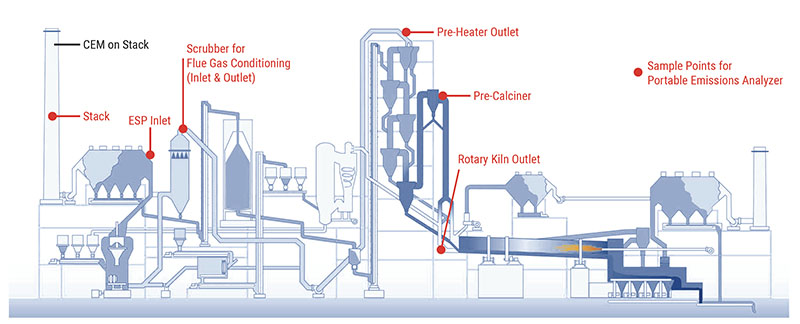Emissions analysis in a cement plant
There are many points within a cement plant that should be monitored and measured with a portable gas emissions analyzer to maximize product quality, combustion efficiency, safety and emissions reduction.
Problems related to emissions analysis in a cement plant
The use of a continuous emissions analyzer (CEM: Continuous Emission Monitor) is necessary to monitor the gases leaving the main chimney in order to ensure compliance with emissions regulations.
However, if there are irregularities in the emissions, this type of monitoring does not allow us to quickly identify the source of the problem. This is where the portable emissions analyzer steps in.
the use of a portable analyzer with a high temperature probe is essential for measuring the parameters that significantly affects the production process along with the quality of the product, the efficiency of the kiln’s combustion and the emissions generated at various points of the system.
Sampling point and involved gases
Here a list of possibile samplonig point in a cement plant and the gases involved in the process.
- Rotary kiln gas outlet: O₂, CO, NOx, CO₂, SO₂, CxHy, temp.
- Pre-heater & Pre-calcination kiln: O₂, CO, NOx, CO₂, temp.
- Exhaust gas conditioning system: CO, NOx, SO₂ and CO₂
- Electrostatic Precipitator (ESP): CO
- Main chimney: O₂, CO, NOx, CO₂, SO₂ and CxHy.

Seitron emissions analyzers
Seitron offers two solutions – the Chemist 900 Rack for continuous analysis and the Chemist 900 as a portable analyzer.
Indeed, the Chemist 900 can even be set up as a kit suitable for use in cement factories thanks to the provision of a high-temperature sampling probe, specific cement dust filters for the sampling, a built-in gas cooling system and accurate measurement of O₂, CO, CO₂ and both NO and NO₂ for the calculation of the total NOx, SO₂ and CxHy .